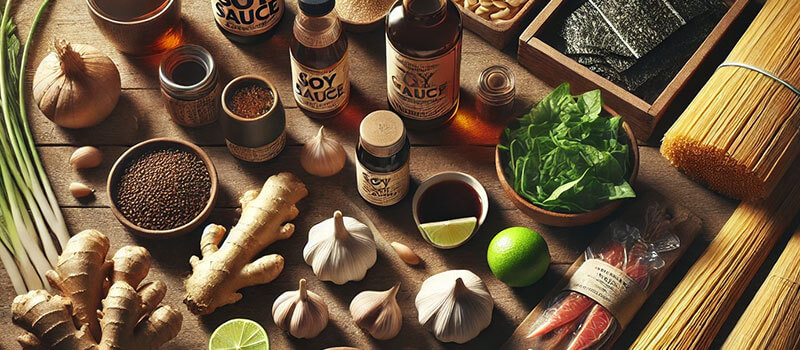7 Essential Ingredients for Authentic Asian Cuisine
Asian cuisine is one of the most diverse in the world. Each country – from Japan through China and Thailand to Vietnam – has its own typical ingredients and flavors that make its dishes unique. If you also want to prepare authentic Asian dishes at home, all you need is a few key ingredients.
And to make preparation easier, we recommend using a high-quality chef’s knife, a Japanese mandoline, and a sharp peeler for vegetables to simplify slicing and ingredient preparation.
Soy Sauce – The Foundation of Umami Flavor
Soy sauce is one of the most important ingredients in Asian cuisine. This dark, salty, and aromatic seasoning is made by fermenting soybeans, wheat, water, and salt. Thanks to natural fermentation, it develops a deep, complex umami taste that adds richness and balance to dishes. Umami is one of the five basic taste sensations, alongside sweet, salty, sour, and bitter. The term originates from Japanese and means "delicious" or "distinctive flavor." Umami is often described as meaty, rich, deep, and long-lasting, enhancing the overall taste of food.
It is used in almost all types of Asian dishes – from meat marinades to stir-fry seasonings, soups, noodle dishes, and dips. In Japanese cuisine, it is essential for sushi rice, ramen, and teriyaki sauce, while in Chinese cuisine, it is indispensable in dishes such as Kung Pao chicken or fried Chow Mein noodles. Where else is soy sauce used?
 Chinese fried noodles
Chinese fried noodles
 Teriyaki sauce
Teriyaki sauce
 Chicken Kung Pao - try the Kung Pao Chicken Recipe from ApetitOnline.cz
Chicken Kung Pao - try the Kung Pao Chicken Recipe from ApetitOnline.cz
Rice Vinegar – Gentle Acidity for Sushi and Salads
Rice vinegar is one of the essential ingredients in Asian cuisine. Unlike regular vinegar, it is milder, less acidic, and has a slightly sweet taste. It is primarily used in Japanese, Chinese, and Vietnamese gastronomy, where it provides a balanced depth of flavor.
The most well-known use of rice vinegar is in seasoning sushi rice, where it is mixed with sugar and salt to achieve the perfect taste. It is also great for Asian salads, such as Sunomono, a traditional Japanese cucumber salad. In Chinese cuisine, it is often added to sauces and marinades, balancing the saltiness of soy sauce and giving dishes a refreshing touch. You can also find rice vinegar in these dishes:
 Sushi rice - prepare it at home using this Sushi Recipe from KuchyneLidlu.cz
Sushi rice - prepare it at home using this Sushi Recipe from KuchyneLidlu.cz
 Cucumber salad Sunomono
Cucumber salad Sunomono
 Kimchi
Kimchi

Miso Paste – A Fermented Flavor Bomb
Miso paste is one of the fundamental pillars of Japanese cuisine, with a history dating back over a thousand years. This unique ingredient is made by fermenting soybeans with rice or barley, developing a rich, salty flavor full of umami.
Thanks to its nutrient-dense profile filled with probiotics, proteins, and minerals, miso is not only delicious but also healthy. Adding miso paste to sauces or dips gives dishes an incredible depth of flavor. Some typical dishes featuring miso paste include:
 Miso Soup - Try this cauliflower miso soup recipe from iPrima.cz
Miso Soup - Try this cauliflower miso soup recipe from iPrima.cz
 Butter Chicken with Miso - Prepare Butter Chicken with Miso and Garlic from iPrima.cz
Butter Chicken with Miso - Prepare Butter Chicken with Miso and Garlic from iPrima.cz
 Miso Ramen - Test this fresh ramen recipe
Miso Ramen - Test this fresh ramen recipe
Fish Sauce – Essential in Thai and Vietnamese Cuisine
Fish sauce is one of the most distinctive seasonings in Asian cuisine, giving dishes a deep and rich umami flavor. It is made by fermenting anchovies or other small fish with salt, producing a strong aroma and a perfectly balanced combination of salty, sweet, and tangy notes.
It is an essential part of Thai and Vietnamese cuisine, used to enhance soups, wok dishes, marinades, and as a base for sauces. In Vietnam, fish sauce is a key ingredient in Pho, the popular Nuoc Cham dipping sauce served with spring rolls, and grilled dishes like Bun Thit Nuong. In Thai cuisine, it is indispensable for dishes like Pad Thai, Som Tam (green papaya salad), and Tom Yum soup. You’ll also find fish sauce in these dishes:
 Pad Thai
Pad Thai
 Pho - Try this Pho Bo Tai recipe from iPrima.cz
Pho - Try this Pho Bo Tai recipe from iPrima.cz
 Nuoc Cham
Nuoc Cham
Coconut Milk – A Key Ingredient for Curry
Coconut milk is one of the most important ingredients in Thai, Indian, and Indonesian cuisine, where it gives dishes a rich, creamy texture and a mildly sweet flavor. It is obtained by pressing the pulp of ripe coconuts and is an essential component of many traditional dishes.
Most commonly, coconut milk is used as a base for Thai curries, where it is mixed with curry pastes and aromatic spices. Thanks to it, the curry achieves a silky consistency and a perfect balance between spicy and mild flavors. It is also used in soups, such as Tom Kha Gai, where it creates a rich and creamy broth with hints of lemongrass and galangal.
Besides savory dishes, coconut milk is also popular in Asian desserts, such as Mango Sticky Rice, where it is combined with glutinous rice and sweet mango. It is also great for smoothies or as a plant-based alternative to cow's milk in modern cuisine. Enjoy coconut milk in these dishes:
 Tom Kha Gai - Try the Tom Kha Gai chicken soup recipe from iPrima.cz
Tom Kha Gai - Try the Tom Kha Gai chicken soup recipe from iPrima.cz
 Thai Red Curry - Try Thai Red Curry Chicken from ApetitOnline.cz
Thai Red Curry - Try Thai Red Curry Chicken from ApetitOnline.cz
 Mango Sticky Rice
Mango Sticky Rice
Nori Seaweed – Not Just for Sushi
Nori seaweed is one of the most well-known seaweeds in Asian cuisine, primarily due to its use in sushi maki. However, it is much more versatile, with its delicate, slightly salty umami taste making it suitable for a variety of dishes.
These dried seaweeds are often used as toppings for ramen soups, on onigiri (Japanese rice balls), or as a seasoning for rice dishes. Finely crushed nori flakes can be a great addition to salads, noodle dishes, or as a flavorful topping for homemade snacks – such as roasted edamame or popcorn.
In addition to its great taste, nori seaweed is rich in minerals, iodine, vitamins, and antioxidants, making it an excellent nutritional supplement for a healthy diet. Where can you find Nori?
 Tom Kha Gai - Try the Tom Kha Gai chicken soup recipe from iPrima.cz
Tom Kha Gai - Try the Tom Kha Gai chicken soup recipe from iPrima.cz
 Onigiri
Onigiri
 Ramen Topping
Ramen Topping
Fresh Ginger and Garlic – The Base for Marinades and Wok Dishes
Ginger and garlic form an iconic duo in Asian cuisine and are key to rich and aromatic dishes. Their unique combination not only adds a distinctive flavor to dishes but also offers health benefits.
Ginger has a fresh, slightly spicy taste with citrusy notes and is essential in Thai, Chinese, and Japanese dishes. It is used in meat marinades, as a base for soups, or as a seasoning for stir-fry wok dishes. It pairs excellently with Ginger Chicken or Miso Soup.
Garlic adds a rich aroma and depth of flavor to dishes. It is found in classic Asian marinades, sauces, and fried dishes. Together with soy sauce, it forms the foundation for Chinese Kung Pao Chicken, Thai Pad Kra Pao (basil chicken), or Vietnamese Pho soup, as well as:
 Ginger Chicken - Try this Ginger Chicken recipe from iPrima.cz
Ginger Chicken - Try this Ginger Chicken recipe from iPrima.cz
 Kimchi
Kimchi
 Fried Rice
Fried Rice
When you have the right ingredients in your kitchen, preparing Pad Thai, Pho, or Sushi at home is easy. And to make food preparation effortless, it’s useful to have high-quality chef's knives for cutting, a Japanese mandoline slicer for perfect julienne cuts and slices, or a sharp vegetable peeler for quick peeling.
Do you have a favorite and tested recipe for Asian dishes? Share it in the comments so we can try it out!





















































